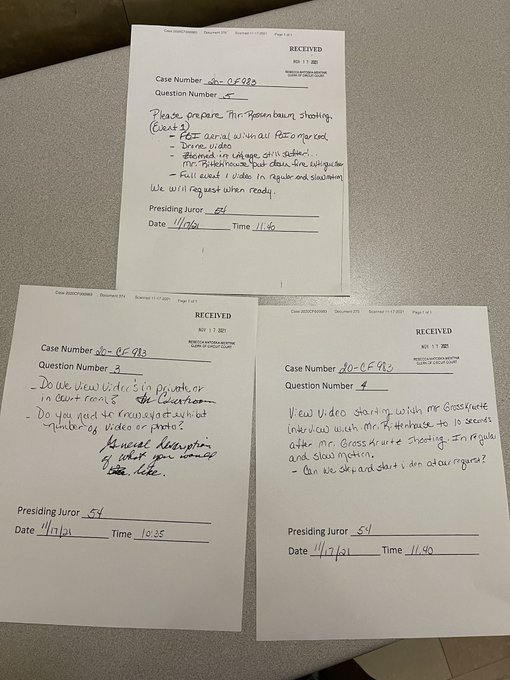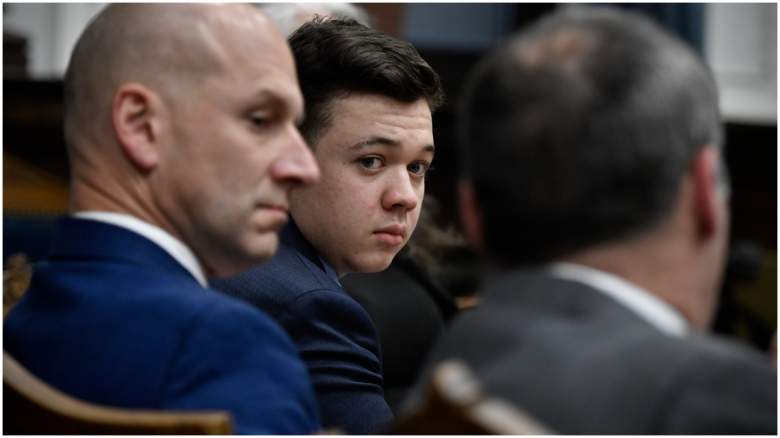
Getty Kyle Rittenhouse was found not guilty on all charges related to the August 2020 shooting deaths of two men and wounding of another.
Kyle Rittenhouse has been found not guilty on all charges after a closely watched and hotly contested trial that stemmed from his shooting of three men during the unrest following a controversial police shooting in Kenosha, Wisconsin.
Rittenhouse, who appeared shaken as the verdicts were read, broke into tears and hugged his defense attorney when the verdict was announced.
The news first broke around 10:55 a.m. on Friday, November 19, 2021, in the fourth day of deliberations, that the Rittenhouse jury had reached a verdict, according to an email Kenosha police sent to law enforcement personnel. Here is that email, with identifying information removed.

Kenosha police
The news spread quickly.
The verdict was revealed around noon, and Rittenhouse, 18, was acquitted of all counts, including two homicide charges.
There was speculation of a hung jury as deliberations continued into a fourth day without a verdict, with the jury sending a series of notes to the judge asking to review the voluminous videos in the case.
However, a hung jury did not happen, and Rittenhouse was acquitted in a closely watched and hotly debated case that sprang from the riots and protests following the Kenosha, Wisconsin, police shooting of Jacob Blake. The officer in that case was cleared by the local DA.
Rittenhouse was charged in the deaths of Joseph Rosenbaum and Anthony Huber, in the wounding of Gaige Grosskreutz, and with recklessly endangering the safety of two other men. A charge for illegal firearm possession was dismissed on November 15 by the judge, who cited the wording in state law. A curfew ticket was also dismissed on November 9 by the judge, Bruce Schroeder. The longest-serving circuit judge in Wisconsin, Schroeder, 75, was the focal point of controversy over his pretrial rulings and comments in court.
According to WISN-TV, defense attorney Mark Richards said, “I thought the jury was 6-6 split,” as he left the courthouse on November 18, 2021, after the jury couldn’t reach a verdict following the third day of deliberations, but the outlet said he was speculating.
In the end, the jury reached a verdict on every count.
You can read the jury instructions in full here.
Here’s what you need to know:
1. Dramatic Videos Capturing the Shootings Were the Focus of the Trial
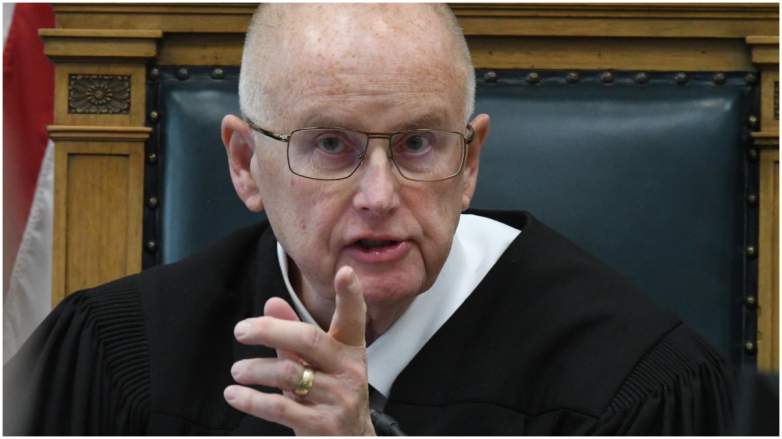
GettyJudge Bruce Schroeder
The trial featured witness after witness who didn’t seem to do the prosecution any favors. Under Wisconsin law, the defense needed to show that Rittenhouse reasonably believed he was in imminent danger of death or great bodily harm at the time he fired. The jury agreed with them, ultimately. The prosecutors bore the burden of proof to show it was not self-defense, but witnesses testified that Rittenhouse was being chased, attacked with a skateboard, had a gun pointed at him, and other elements that made the defense case.
They were mostly prosecution witnesses who did that, as well, in a case the elected District Attorney, Michael Graveley, handed off to two assistants, Thomas Binger and James Kraus.
Videos were the centerpiece of the trial as live streamers and drone videos captured the shootings. You can see a round-up of the key photos and videos in the case here.
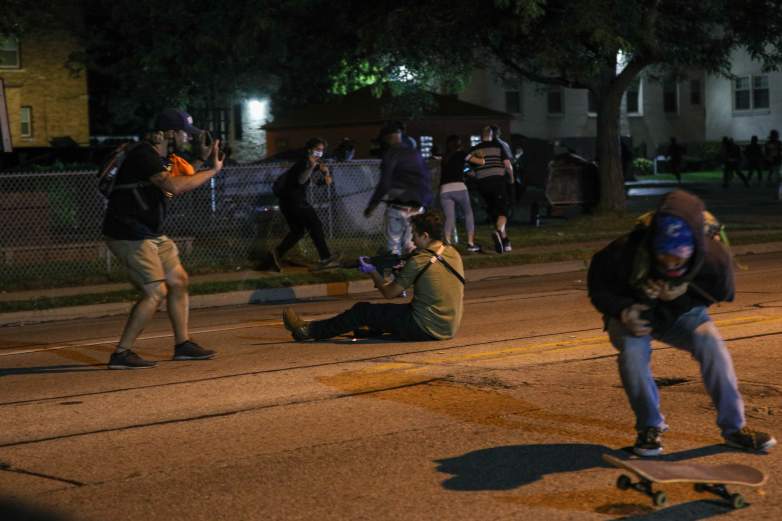
GettyThe shooting scene.
Trial testimony showed Rittenhouse had gone to Kenosha that day to work as a lifeguard. He cleaned graffiti off a public building and then took a rifle to guard a local business named Car Source, whose other outlet was destroyed by arsonists in the days before. In contrast, jurors heard many descriptions from witnesses and videos of Joseph Rosenbaum, the first man shot, getting into verbal altercations, acting belligerent, and even using a racial slur throughout the night.
Trial testimony indicated that Rittenhouse went to Car Source with a Kenosha friend. Rittenhouse’s father lived in Kenosha as did extended family. They hung out with other people who came from around Wisconsin to help guard the business as well, some of them combat veterans from Iraq and Afghanistan. But Rittenhouse did not know them before that night, testimony showed.
2. Witnesses Testified That Rittenhouse Was Being Chased & Struck During the String of Incidents
As the night progressed, fights and other arsons broke out in the streets of Kenosha. Rittenhouse was walking back to a Car Source outlet, when, video shows, Joseph Rosenbaum, a convicted child molester, chased Rittenhouse into the corner of a car lot. Richie McGinniss, a journalist with the Daily Caller, was behind Rosenbaum and testified that Rosenbaum reached for Rittenhouse’s gun. The medical examiner testified that Rosenbaum was no more than four feet from Rittenhouse when Rittenhouse opened fire. Rosenbaum’s hand was either touching or very close to Rittenhouse’s gun, a medical examiner testified, but he said a hand wound was shot two.
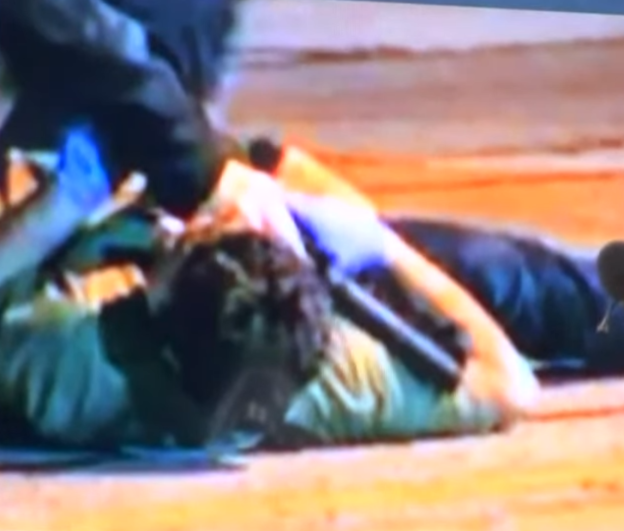
Court exhibitDefense exhibit showing Anthony Huber touching Rittenhouse’s gun.
Rosenbaum died at the scene. Prosecutors had tried to argue that Rittenhouse provoked the Rosenbaum chase by pointing a gun at an armed man named Joshua Ziminski. Ziminski was never called to the stand; he is facing arson and other charges stemming from that night. He, both sides say, fired a gun in the air right before Rittenhouse shot Rosenbaum. The defense claimed prosecutors gave them a lesser quality video of the one they used in their provocation arguments. They also denied that Rittenhouse pointed his gun at Ziminski. The prosecution’s exhibits were, in some cases, very blurry on this point.
Provocation would not have excluded Rittenhouse from having a right to self-defense, but did require that he exhausted all avenues for escape and gave Rosenbaum adequate notice that he was doing so. However, the video showed he was running away until cornered near cars with vandals on the other side.
After shooting Rosenbaum, Rittenhouse ran down the street in the direction of a police line. A crowd began to run after him with people identifying him as a shooter. He fell in the street. At that point, a man called Jump Kick Man ran and delivered a kick, possibly to his head, and Anthony Huber ran toward him with a skateboard, hitting him with it, and defense attorneys argued, trying to grab Rittenhouse’s gun.
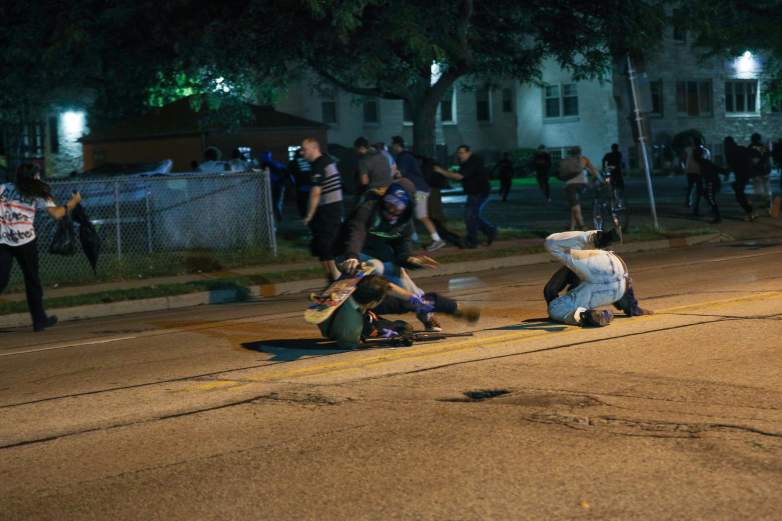
GettyKenosha shooting
Gaige Grosskreutz, an affiliate of the People’s Revolution group and a medic, then approached Rittenhouse. He testified that he pointed a gun at Rittenhouse while advancing toward him at close range, even though he was a prosecution witness. Rittenhouse shot him in his bicep. However, defense attorneys presented a photo they said showed Grosskreutz pointing the gun at Rittenhouse. Prosecutors argued his arm was dangling because he was shot, but, again, he admitted pointing the gun on the stand.
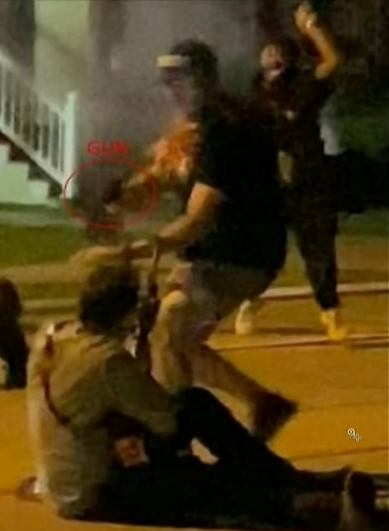
ExhibitGaige Grosskreutz in a photo presented in court. Rittenhouse is on the ground
Prosecutors argued that the crowd had a right to stop what prosecutor Thomas Binger called an “active shooter.”
Rittenhouse then ran down the street and tried to surrender to police, who didn’t realize he was the shooter. He later turned himself in at Antioch, Illinois.
3. Rittenhouse Dramatically Broke Down on the Stand

GettyKyle Rittenhouse breaks down on the stand.
Rittenhouse broke down crying on the witness stand on November 10, 2021, sobbing in court as he recounted the first shooting, of Joseph Rosenbaum.
This was a gamble by defense attorneys, as it’s always a risk to put a defendant on the stand. But it may have worked by humanizing Rittenhouse.
Watch live video of Rittenhouse’s testimony:
Although calling a defendant to the stand is almost always a risky proposition for a defense team, in self-defense cases it can be necessary because the jury will be instructed that self-defense requires a showing that Rittenhouse reasonably believed his life or that of another was in imminent danger or that they were in imminent danger of great bodily harm.
Rittenhouse testified that he defended himself when Rosenbaum started chasing him toward a car outlet parking lot. Rosenbaum threw a plastic bad at him. A medical examiner previously testified that Rosenbaum was shot four times; the first wound, to the hip, came when Rosenbaum was no more than four feet from Rittenhouse and possibly closer. The second shot came to Rosenbaum’s hand. Soot indicated that Rosenbaum was either in contact with the gun with his hand or very close to it when shot. The third and fourth shots, to the head and back, came when Rosenbaum was in a horizontal position almost like Superman, Dr. Douglas Kelley testified. The chase is seen on video.
“I didn’t do anything wrong. I defended myself,” he testified.
He added, “I brought the gun to protect myself.” Rittenhouse said he thought the bag Rosenbaum threw at him was a chain that Rosenbaum was carrying earlier in the night (he’s been photographed holding it earlier.)
“I didn’t know if it was going to kill them, but I used deadly force to stop the threat that was attacking me, Rittenhouse said.
Rittenhouse was also asked about the other two shootings. Gaige Grosskreutz was shot and lived. “My rifle is down. His hands are up. His pistol is in his hand, and then he looks at me, and that’s when he brings his arm down…like his arm is like that with me on the ground and his pistol is pointed at me,” Rittenhouse testified about the moment he shot him.
“That’s when I shoot him.” Grosskreutz testified before the prosecution rested and admitted on the witness stand that he was pointing a gun at Rittenhouse from three-five feet away and was advancing toward Rittenhouse when Rittenhouse shot him. He also testified that he feared for Rittenhouse’s safety from Huber, who was hitting him with a skateboard after rushing toward him.
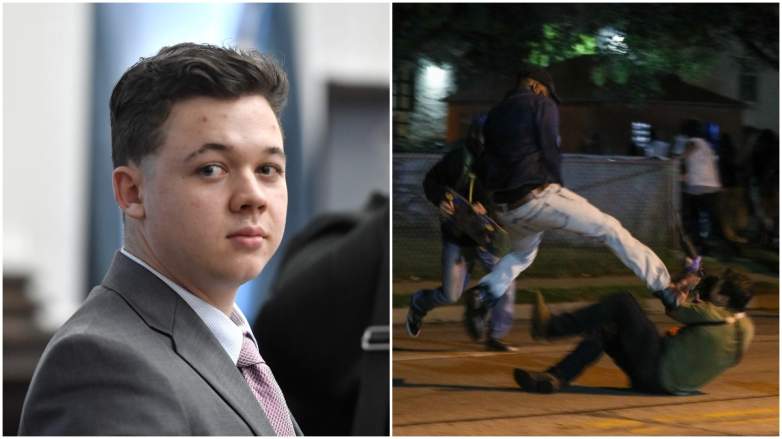
GettyKyle Rittenhouse
Grosskreutz testified that he believed Rittenhouse was an active shooter. After shooting Rosenbaum first, Rittenhouse had run down the street, testimony indicates toward the police, but he fell in the middle of the street. That’s when Huber rushed him, and then Grosskreutz approached. Those shootings are on video.
“As I’m running past Mr. Huber, he’s holding a skateboard like a baseball bat and he swings it down and I block it with my arm trying to prevent it from hitting me, but it still hits me in the neck. And as I block it, it goes flying somewhere off into the distance,” Rittenhouse said. “As I’m on the ground, there are people around me, I don’t recall how many, but I remember moving my rifle in their direction and they back off besides one person.” The defense introduced a photo they say shows Huber making contact with Rittenhouse’s gun. They are arguing Huber and Rosenbaum were trying to disarm Rittenhouse.

Court exhibitDefense exhibit showing Anthony Huber touching Rittenhouse’s gun.
He also described a kick from a man called “jump kick man,” by prosecutors, who is seen on video rushing him.
“As his boot is making contact with my face, I fire two shots at him,” Rittenhouse said.
“Why did you shoot at him?” defense attorney Mike Richards asked.
“He would have stomped my face in if I didn’t fire,” Rittenhouse replied.
You can see video in the case here.
4. The Jury Was Drawn From Kenosha County & Tilted Female

GettyKyle Rittenhouse
Who were the jurors? Their identities were not revealed. However, there were seven women on the Rittenhouse jury and five men.
The jurors were drawn from Kenosha County. All but one appeared white, and they were middle-aged to elderly in almost all cases.
There were several incidents with the jury during the trial. The judge kicked MSNBC out of the courtroom when a freelancer was accused of following the jury bus; the network denied that was his intent. There was an earlier incident where someone was videotaping jurors, the judge announced in court. Concerns about jury intimidation grew.
Protests and counter-protests broke out throughout the week.
The defense attorneys had filed a motion for a mistrial with prejudice that is now rendered moot; the judge had not yet ruled on it. They accused prosecutors of intentionally doing things like giving them a compressed video of the shooting of Rosenbaum that was worse quality than the one the state used.
5. The Jurors Sent Several Notes to the Judge
There were a few clues about what jurors were thinking; they sent some notes to the judge. They were sent in the handwriting of a female juror known as “juror 54.”
One note asked for the drone video and a series of other pieces of evidence that may indicate they are scrutinizing the provocation argument closely. They also asked for an FBI infrared video that was shown in court.
Other notes showed jurors wanted to see video relating to the shooting of Grosskreutz, who testified that he pointed a gun at Rittenhouse while advancing toward him at close distance because he believed he was an active shooter.
A juror asked the judge on November 18, 2021, if the jurors could take the jury instructions home and was told yes.
READ NEXT: These Are the 13 Marines & Service Members Who Died in the Afghanistan Attack at Kabul Airport


